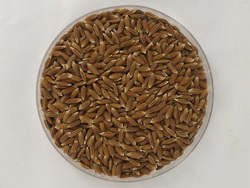Description
🚚 Fastest delivery time: 2 day delivery.
🐝 Supplier / Origin: Golden Resource Rice Group / Made in Hong Kong
🔖 Certification: Certification number:
🌱 Supplier introduction:
Mr. Lam Sai Ho, vice chairman of Golden Resources Rice Group, said that "Huayaozi" has been lost for a long time, and this local restoration is unprecedented. He described the "flower waist boy" as having a special texture with a faint vanilla aroma. "Every time I taste it, I can taste the history of Hong Kong." Also known as "flower waist boy", the grains of "flower waist boy" are distinct and easy to be stained with rice juice. "Hong Kong food should be returned to Hong Kong with rice."
Lam Hon-ming, head of the Hong Kong Seed Technology and Education Center and director of the State Key Laboratory of Agricultural Biotechnology (The Chinese University of Hong Kong), described seeds as "living history", witnessing Hong Kong's agricultural history and the hope of farmers passed down from generation to generation. In order to maintain the purity and taste of the "Hua Yao Zai" seeds, the team sequenced the genes of the seeds, found out their unique genetic markers, and developed a "genetic identity card" for the seeds, which can be tested and compared in the future.
🛍 Product information:
In the 1960s, local rice seed lines were sent to seedbanks overseas with a view to preserving local heirloom rice varieties and conserving local varieties with historical origin.
In 2019, AFCD had acquired rice seeds of local varieties from USDA (USA) and IRRI (International Rice Research Institute, Philippines).
Fa Yiu Tsai
See Mew
Chai Mei
Pak Huk Chai Mei
... the local rice names in Hong Kong you must know!
In the 1950s and 1960s, "Hua Yao Zai" was abundant in the Kam Tin area of Yuen Long. Just like "which came first, the chicken or the egg", to grow rice, you must first have grain seeds. In the past, most local farmers kept their own seeds, or exchanged or donated them with friendly farmers. Grain seeds can be cultivated into a meter of grain every month, year after year. However, this cycle of seed preservation has been terminated by the rice fields that have been abandoned for many years.
Fortunately among misfortunes, in the early 1960s, the International Rice Research Institute (IRRI) in the Philippines had extensively collected rice seeds from various places, and rice seeds from Hong Kong also came to this institute established by a US foundation in batches. Today it is the most important rice research center in the world. When local rice varieties were lost, IRRI and the Natural Small Grain Collection and Genetic Stocks Oryza Collection in the United States became the only place to rely.
When "The Earth Gives Us" wanted to restore Hong Kong rice, the seeds that had been dispersed overseas for decades returned to the mainland from the United States and the Philippines. Although the soil and water of Hong Kong are no longer what they used to be, the rice seeds can still be regarded as "recognizing their ancestors". Return to the clan."
Currently, there are more than 600 kinds of seeds stored in the center, among which there are more than 40 varieties of rice. From the public information on the official website, the Chinese and English names of each variety, where they were collected, and Its planting characteristics (if any information is available), etc. In the seed bank, through the glass door of the refrigerator, you can read these imaginative rice names one by one: "gold-wrapped silver", "mouse tooth", "white shell Qi Mei", "hualuobai", "huayaozi" ", "Guangdong Nong Silk Seedlings", "Yellow Shell Sticky", "Meixue Silk Seedlings"...may be related to the shape of the rice shell, or maybe it describes the geography or climate during planting. There is no lack of poetry and interest in it.

Through the establishment of the Hong Kong Seed Bank, precious seed variety resources and agricultural knowledge are preserved for future generations. These rice varieties are divided into categories and neatly arranged bottle by bottle in a freezer at 4 to 7 degrees Celsius and a humidity of about 20%. It is a medium-term storage, allowing flexibility for daily scientific research. The seed bank also has long-term storage. The seeds are vacuum-sealed in aluminum bags and stored in a freezer below -25°C with a humidity of about 10% (or a moisture content of less than 7%). They will not be taken out unless necessary. If all goes well, seeds in long-term storage could have a life expectancy of fifty years.
Source: Ming Pao Weekly 20.09.2024
1950年代から1960年代、元朗のカムティン地区では「花耀仔」(Fa Yiu Tsai)が盛んに栽培されていました。「鶏が先か、卵が先か」のように、米を育てるには、まず穀物の種が必要です。かつて、地元の農家のほとんどは自分の種子を保管するか、友好的な農家と交換したり寄付したりしていました。穀物の種子は毎月、毎年、1メートルの穀物まで栽培することができますが、この種子の保存サイクルは、長年放置されてきた田んぼによって終了しました。
不幸中の幸いだったのは、1960 年代初頭、フィリピンの国際稲研究所 (IRRI) が各地から稲の種子を広範囲に収集していたため、米国の財団が設立したこの研究所にも香港からの稲の種子がまとめて入ってきたことです。は世界で最も重要な米研究センターです。地元の米品種が失われたとき、IRRI と米国の Natural Small Grain Collection および Genetic Stocks Oryza Collection が唯一の頼れる場所となりました。
「地球がくれたもの」が香港米を復活させたいと考えたとき、香港の土壌と水はもう以前のものではありませんでしたが、何十年も海外に散布されていた種子が米国とフィリピンから本土に戻りました。稲の種は依然として「祖先を認識する」とみなすことができます。
現在、センターには600種類以上の種子が保管されており、その中には40種類以上の米が公式ウェブサイトの公開情報から、各品種の中国語名と英語名、採取場所、植栽の特徴(情報があれば)など種子バンクでは、冷蔵庫のガラス扉を通して、想像力に富んだ米の名前を 1 つずつ読むことができます。「金包み銀」、「ネズミの歯」、「白殻チーメイ」、「花羅白」、「花耀子」 」、「広東農蚕苗木」、「黄貝粘り」、「梅雪絹苗木」…米の殻の形状に関係しているのかもしれないし、あるいは田植え時の地理や気候を表しているのかもしれない。詩とそれへの興味。
香港種子銀行の設立により、貴重な種子品種資源と農業知識が将来の世代に保存され、これらの米品種はカテゴリーに分類され、ボトルごとに整然と並べられ、摂氏 4 ~ 7 度、湿度約 2 の冷凍庫に保管されます。 20% は中期保管であり、日々の科学研究に柔軟に対応できます。種子バンクは長期保存も可能で、種子はアルミ袋に真空密封され、湿度約10%(または含水率7%未満)の冷凍庫で保管されます。必要な場合以外は持ち出さないこと。すべてがうまくいけば、長期保存された種子の寿命は50年になる可能性がある。
出典: 明報週刊誌 2024 年 9 月 20 日
参考:香港中文大学生命科学 - 失われた米の復活 2022年9月14日
🥘 レシピ:
地元産のお米「ホアヤオザイ」 粒が透明でタレがつきやすい希少品種です。 1パックでお米約2杯分です。 ラードや卵とよく合います。
Reference:
The local rice "Hua Yao Zai" is a rare variety. "Hua Yao Zai" has clear grains and is easy to be stained with sauce. One pack is about two bowls of rice.


















